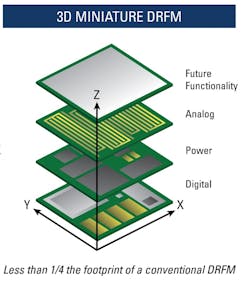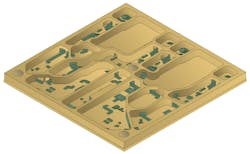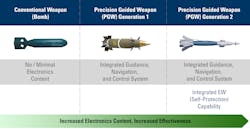Miniaturization of EW Microelectronics for Self-Protecting Weapons
Author: Philip Fulmer, Director of Product Marketing, Advanced Microelectronics Solutions Group, Mercury Systems
The advent of precision guided weapon technologies has greatly reduced the military’s “cost per kill”, along with the associated logistics and supply costs for maintaining a large number of conventional munitions in inventory. Key to this advance is the integration of advanced guidance, navigation and control (GNC) systems using laser, electro-optical, infrared, radar and/or GPS signals to direct the weapon to its designated target. To counter this threat, adversaries are increasingly turning to electronic attack measures to disrupt the operation of these GNC systems.
Mitigation of adversarial attack is accomplished through the integration of self-protection capability into the weapon via digital radio frequency memory (DRFM) microelectronics. However, conventional DRFM microelectronics are far too far large for adoption in modern smart weapons. Even SWaP-optimized microelectronics designed for typical airborne applications are not easily integrated into a weapon.
In order to manufacture these new DRFMs, a new, modular approach to microelectronics using three-dimensional stacking techniques combined with advances in miniaturization and ruggedization technologies is required. Modularity is critical for a number reasons:
- The modular architecture permits the incorporation of additional future functionality and/or higher performance capabilities through the addition of a new board into the PCB stack-up. This agile upgrade and expansion capability also allows emerging threats to be quickly addressed as new advances in RF performance and signal processing are commercialized.
- The separation of noise-sensitive RF components from the digital components found elsewhere in the module enable the entire sensor chain to achieve a significantly higher level of performance.
- Modularity enables the early detection and resolution of manufacturing anomalies that would otherwise go undetected until the fully assembled DRFM module has been tested. This clearly impacts cycle time, factory efficiency and manufacturing cost.
Analog Circuitry Optimization
The majority of the allocated design space within a typical DRFM is occupied by the analog components and corresponding circuitry. The simplest path to begin the miniaturization process is simply to reduce the number of components included in the bill of materials. Although a simple exercise to complete, there are limited opportunities available; those few apparent opportunities come with penalties that must be accepted. Other approaches for minimization of the analog circuitry footprint must be explored.
However, shrinking the analog circuitry for a DRFM application is not enough. The typical application environment for a smart weapon demands that all components be ruggedized to withstand the harshest expected mission operating conditions. The miniature DRFM module must withstand any combination of high frequency mechanical vibration, rapid acceleration during launch, extremes in thermal shock and exposure to moisture, salt water or corrosive environments. Simultaneously miniaturization and ruggedization requires the DRFM architect to completely reevaluate the analog circuitry design approach.
To simultaneously address both requirements, Mercury Systems has commercialized a miniature RF multi-chip module (MCM) device achieving a footprint reduction by a factor of more than three. On the bottom of the MCM device is a ball grid array (BGA) where solder balls carry power and required signals through the circuit board. The board material was carefully selected to balance mechanical integrity and thermal design considerations, given the severe space constraints of the application.
The adoption of bare die components, when available, are key to successful miniaturization of the RF MCM device. However, not all components can be integrated as bare die. Chip and wire construction and surface mount technology must also be integrated into the design. Special attention must be given to the minimization of real estate consumed by these devices without risking device reliability. Few manufacturers have established such hybrid manufacturing capabilities in a single facility; even fewer have the capability of scaling their resources to meet the needs of high-volume production.
Packing density within the MCM must be carefully balanced against mechanical integrity requirements. Success is achieved by balancing mechanical integrity requirements carefully against the height of the board to achieve maximum packing density. In this extreme SWaP-constrained scenario, maximum packing density has been achieved by reducing the isolation wall thickness.
Miniature RF Multi-Chip Module
Digital Circuitry Optimization
The typical digital components of a DRFM module are non-volatile memory and a processor or field programmable gate array (FPGA) device. The intensive processing demands placed on a DRFM application will typically require several gigabytes of memory. With the space constraints and ruggedization requirements for a miniature DRFM described above, a typical dual in-line memory module (DIMM) is not practical.
Memory devices with BGA mechanical and electrical interface are available from commercial memory manufacturers. BGA devices with lead solder have proven their reliability for military applications. Yet the memory capacity needed for this application will likely exceed the capacity of memory offered in a single device from a memory manufacturer.
Valuable real estate on the miniature DRFM’s digital component module will be quickly consumed by adopting multiple memory devices. One potential option is to consider adding an additional memory-dedicated board to the 3-D DRFM stack, but this approach greatly increases the complexity of the overall design while consuming scarce three-dimensional real estate.
Evolution of Weapon Technologies
Three-dimensional packaging technologies have made considerable advances in recent years. Vertically stacking and interconnecting multiple memory devices with error correction control in a single package saves up to 85% of the two-dimension board space relative to a planar array of discrete devices. This space-savings is achieved without sacrificing technical specifications of the individual devices. The most processing-intensive applications can be supported with up to 18 devices in a single, high-reliability module.
Vertical stacking of memory devices does not require a real-estate sacrifice in the third dimension. Modern die thinning processes now yield integrated memory modules with a height profile of less than 2.5 millimeters. Based on the volume of space available, it may be beneficial to place the low-profile memory device on the backside of the board, thereby freeing real estate on the front-side for other components.
The Next-Generation of Smart Weapons
The modern threat environment continues to evolve, faster than ever before. The microelectronics content of weapons systems must continue increasing, both in RF performance and in processing complexity, in response. The miniaturization and ruggedization of microelectronics is no longer sufficient. Microelectronics must be purpose-built for actual military use-case scenarios with an eye towards modularity and overall system optimization.
The adoption of precision guidance technology was a significant milestone for the defense industry in the 20th century. The introduction of highly specialized DRFM microelectronics for self-protection against adversarial electronic attack will be a similar achievement for the 21st century. The defense community must continue embracing commercial technology advances while deploying innovative and upgradeable microelectronics platforms. To learn more about this topic, download the whitepaper entitled “Defining a Second Generation of Precision Guided Weapons Part II: Reevaluating Strategies for Digital RF Memory” from Mercury Systems.
About Mercury
Mercury Systems is a leading commercial provider of secure sensor and safety-critical processing subsystems. Optimized for customer and mission success, Mercury’s solutions power a wide variety of critical defense and intelligence programs. Headquartered in Andover, Mass., Mercury is pioneering a next-generation defense electronics business model specifically designed to meet the industry’s current and emerging technology needs. To learn more, visit www.mrcy.com.



